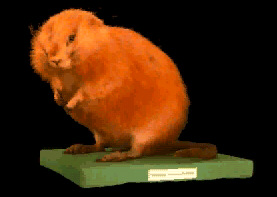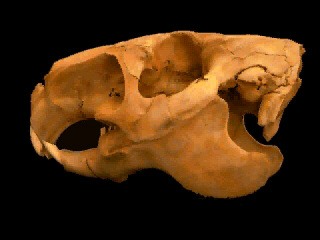
RODENTS
CLASS MAMMALIA
SUBCLASS THERIA
INFRACLASS EUTHERIA
ORDER RODENTIA
| The 1999 species of rodents, in 431 genera and 28 families, described to date possess a characteristic dentition. Accounting for more than 40% of all mammalian species, rodents are found throughout the world in a wide range of habitats: forests, deserts, mountains, the high artic tundra, and often in close contact with humans. Many spend much of their lives in water. |  |
Rodents are important members of food chains - serving as food for large numbers of carnivorous mammals and birds. They manage to survive by producing many large litters a year.
Because of their enormous populations, rodents are of great significance to humans:
- beavers and squirrels help to shape the environment;
- guinea-pigs, capybara and cane-rats provide food;
- rats and mice are pests - feeding and damaging grain;
- many small rodents - including rats, mice, ground squirrels -
are reservoirs of diseases, like plague
The three main types of rodents have characteristic arrangements of the jaw musculature and different shaped skulls. They were previously assigned to three sub-orders:
- Sciuromorpha - squirrel-like rodents;
- Myomorpha - mouse-like rodents;
- Caviomorpha - cavy-like rodents.
- sub-order Sciurognathi: squirrel-like rodents and mouse-like rodents;
- sub-order Hystricognathi: cavy-like rodents.
Dentition and digestion
| Rodents possess a pair of razor-sharp incisors used to gnaw through
the hard outer coats of seeds, tree bark and, in the case of beavers, even
whole tree trunks. Most rodents eat a range of food: leaves, fruit, seeds,
and even small invertebrates.
The incisors are constantly worn down by the action of the opposing
tooth on the opposite jaw. These teeth have open roots and grow
continuously throughout life. Rodents have no canines but their cheek teeth
are specially adapted to grind their food into fine particles. Their lips can be drawn into the diastema, the space between the incisors and the cheek teeth, to prevent inedible fragments being swallowed or, in the case of beavers, water being swallowed when the animals chew wood under water. |  |
Rodents cope with the cellulose in their food in a similar way to Lagomorphs. Food processed in the stomach passes down the intestine to the caecum where the cellulose is processed by bacteria. As the products can only be absorbed higher up in the gut, rodents re-ingest the food processed in the caecum directly from the anus. The nutrients are then absorbed as the food passes through the stomach for the second time; the hard faecal pellets produced in this way are not ingested.






